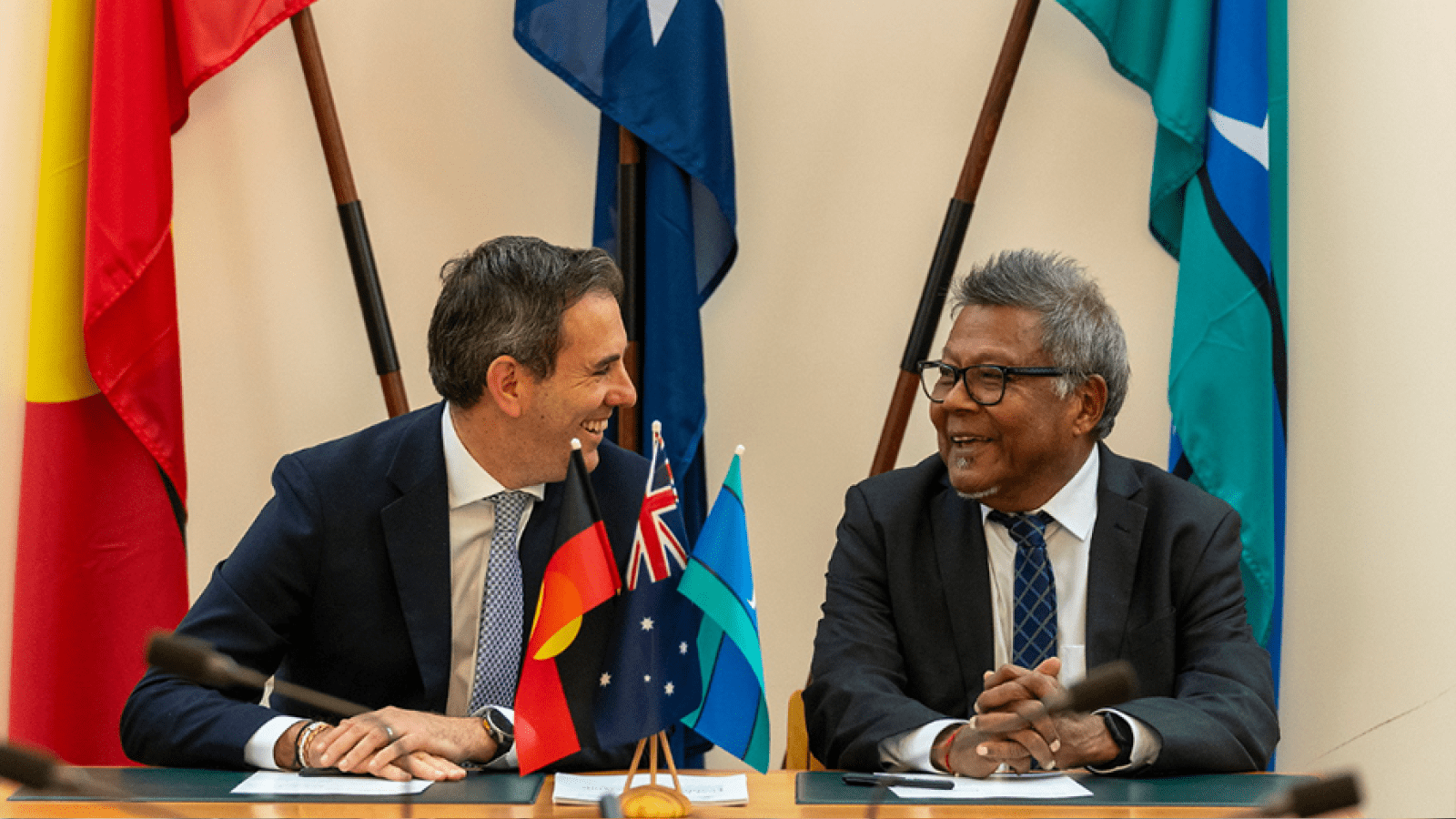Historic Indigenous economic framework signed

Treasurer Jim Chalmers signed the National Indigenous Economic Partnership Framework Agreement, pictured with Professor Peter Yu at Parliament House, Canberra, Australia. Photo: Jamie Kidston/ANU.
Article by Paul Richards
Indigenous Australians have been given a seat at the table to shape future economic policy through a historic agreement signed by the Federal Government.
The First Nations Economic Partnership was spearheaded by an alliance of committed Indigenous people, together with the Australian National University (ANU).
The agreement was signed on 29 September 2025 and creates a way for shared decisions to be made about reforms to First Nations economic policy, leveraging the resources of government.
First Nations Economic Empowerment Alliance Chair and ANU Vice-President (First Nations), Professor Peter Yu, said the agreement is the first of its kind in Australia.
“The economic self‑determination of Indigenous peoples has received little attention, and our communities have never been given a chance to shape our own economic futures. Today that changes,” Professor Yu said.
“The Alliance is focused on a Partnership and Economic Framework that delivers real fiscal reform and structural change – including improved access to capital, Indigenous‑led investment, and greater involvement in the Australian economy.”
First Nations people already have legal interests in 70 per cent of the Australian land mass. In northern Australia those interests are close to 80 per cent.
Aside from extensive interests in land, the Indigenous business sector shows healthy signs of growth, contributing $16 billion to the national economy and employing 116,000 people. But access to affordable investment capital is central to being able to have equity in emerging growth and investment opportunities.
Professor Yu said the challenge is now before Australian policymakers, industry and Indigenous communities to take up this opportunity for genuine economic innovation and reform.
“Indigenous peoples are not a debit on the national balance sheet. This partnership can demonstrate that we are principal partners in the economic future of Australia.”
The partnership will explore potential reforms to the funding model for Prescribed Bodies Corporate to deliver meaningful participation for communities and timely decision‑making for investors.
It will also consider how the Northern Australia Infrastructure Facility and the Australian Renewable Energy Agency can better deliver for First Nations communities across Australia.
“The agreement signals a commitment by the Commonwealth to redesigning economic policies that affect First Nations peoples,” Professor Yu said. “Treasury will now be responsible for coordinating a new, whole-of-government approach to developing economic opportunities, with the cooperation of peak Indigenous organisations and the Economic Empowerment Alliance.”
The new economic partnership will focus on “the full range of policy levers available to the Commonwealth Government to support economic empowerment, self-determination, and wealth creation for First Nations peoples.”
Minister for Indigenous Australians, Senator Malarndirri McCarthy welcomed the signing of the agreement.
“The First Nations Economic Partnership is a new approach to First Nations economic policy and economic prosperity. By working together, we are unlocking the potential of land, culture and community to drive prosperity, not just for today, but for generations to come,” Senator McCarthy said.
Treasurer, Jim Chalmers signed the agreement on behalf of the Federal Government, committing $16.9 million over five years to support the development of a First Nations Economic Framework and establish the Economic Partnership.
He said this partnership puts First Nations decision-makers in the driver’s seat when it comes to steering economic outcomes.
“Government investments, while substantial, are not delivering the outcomes Indigenous Australians need and deserve. This is about helping First Nations Australians to secure more of the jobs and opportunities that we’re creating in our economy.
“It will ultimately mean more support for First Nations workers and businesses, better skills and training pathways for First Nations people and more participation in the economic projects that create opportunities for First Nations communities,” he said.
The other major signatory on the First Nations Economic Partnership was the Coalition of Peaks, which worked on the National Agreement on Closing the Gap.
Lead Convenor of Coalition of Peaks, Pat Turner, said genuine change depends on it being implemented properly.
“Reflecting what Aboriginal and Torres Strait Islander people told the Coalition of Peaks through a nationwide engagement process in 2024, our focus will be for the Economic Partnership to design funded programs to grow secure employment and career pathways in our community‑controlled organisations.”
The First Nations Economic Empowerment Alliance was established in 2023, after three years of work and research on Indigenous economic empowerment undertaken by the ANU First Nations Portfolio.
Torres Strait Islander woman and founding member of the Alliance, Leah Armstrong, said the agreement compels governments to reset how it works with First Nations peoples.
“Today is about laying a strong foundation so that future generations inherit an economy that works for them – an economy where First Nations peoples have a seat at the table, a real stake in the economy, and the power to shape our shared prosperity.”
This article was originally published by ANU Reporter, here.